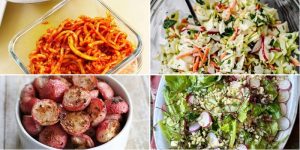You’re about to discover the secret to perfectly cooked fish every time! Whether you’re craving quick weeknight dinners, healthy meals, or impressive dishes for guests, these 30 baked fish recipes will transform your oven cooking. From flaky white fish to rich salmon creations, get ready to find your new favorite seafood masterpiece that’s both delicious and surprisingly simple to prepare.
Herb-Crusted Baked Salmon
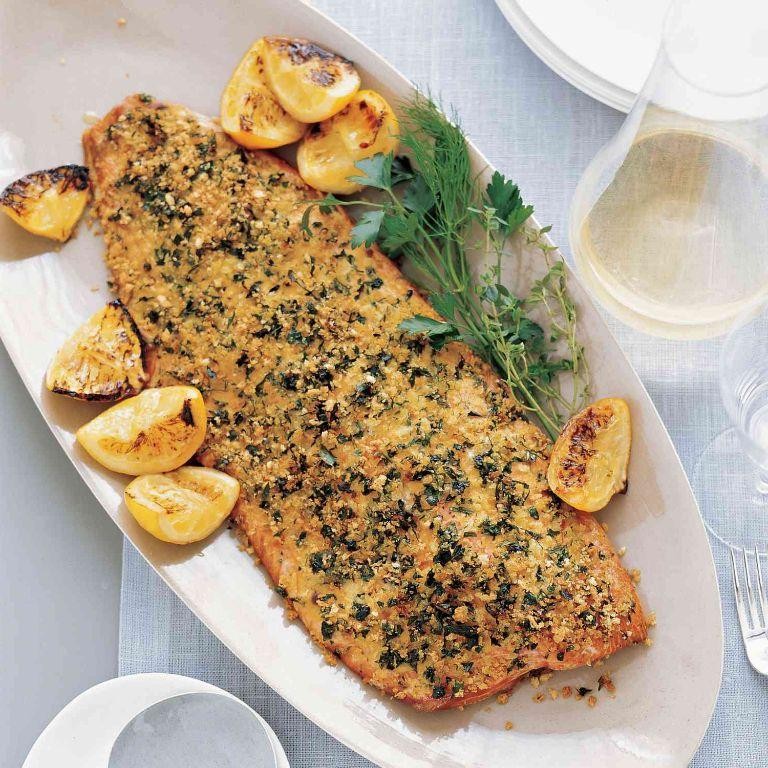
Let’s create a simple yet impressive herb-crusted baked salmon that’s perfect for weeknight dinners yet elegant enough for company. This method ensures perfectly cooked, flaky fish with a flavorful herb crust that comes together in minutes. Following these steps carefully will give you restaurant-quality results right from your own kitchen.
3
portions15
minutes15
minutesIngredients
– 1.5 lbs salmon fillet, skin-on or skinless (pat dry with paper towels for better crust)
– 3 tbsp olive oil (or any neutral oil like avocado oil)
– 1/4 cup fresh parsley, finely chopped (measure after chopping)
– 2 tbsp fresh dill, finely chopped (dried works but fresh is preferred)
– 2 cloves garlic, minced (about 2 tsp)
– 1/4 cup panko breadcrumbs (regular breadcrumbs can substitute)
– 1 tbsp lemon juice (freshly squeezed for best flavor)
– 1/2 tsp salt (kosher salt recommended)
– 1/4 tsp black pepper (freshly ground)
Instructions
1. Preheat your oven to 400°F and line a baking sheet with parchment paper.
2. Pat the salmon fillet completely dry using paper towels to ensure the crust adheres properly.
3. In a small bowl, combine olive oil, chopped parsley, chopped dill, minced garlic, panko breadcrumbs, lemon juice, salt, and black pepper.
4. Mix the herb mixture thoroughly until all ingredients are well incorporated and form a paste-like consistency.
5. Place the dried salmon fillet on the prepared baking sheet, skin-side down if using skin-on salmon.
6. Spread the herb mixture evenly over the top surface of the salmon, pressing gently to help it adhere.
7. Bake the salmon in the preheated 400°F oven for 12-15 minutes, depending on thickness.
8. Check for doneness by inserting a fork into the thickest part – the salmon should flake easily and register 145°F on an instant-read thermometer.
9. Remove the salmon from the oven and let it rest for 3 minutes before serving to allow juices to redistribute.
Flaky and moist with a crisp herb topping, this salmon pairs beautifully with roasted vegetables or a simple quinoa pilaf. The combination of fresh herbs and garlic creates an aromatic crust that complements the rich salmon flavor without overpowering it. For an elegant presentation, serve individual portions with a lemon wedge and sprinkle of fresh dill over steamed asparagus.
Parmesan Crusted Baked Tilapia

Haven’t you been searching for a simple yet impressive fish recipe that delivers restaurant-quality results with minimal effort? Parmesan Crusted Baked Tilapia is your answer—a foolproof dish where flaky white fish gets a golden, cheesy crust in under 30 minutes. Let’s walk through each step together to ensure perfect results every time.
3
servings10
minutes15
minutesIngredients
– 4 tilapia fillets (about 6 oz each, thawed if frozen)
– 1/2 cup grated Parmesan cheese (freshly grated melts best)
– 1/4 cup panko breadcrumbs (for extra crunch)
– 1 tbsp olive oil (or any neutral oil)
– 1 tsp garlic powder
– 1 tsp paprika (adds color and mild heat)
– 1/2 tsp salt
– 1/4 tsp black pepper
– 1 lemon, cut into wedges (for serving)
– Fresh parsley, chopped (optional garnish)
Instructions
1. Preheat your oven to 400°F and line a baking sheet with parchment paper.
2. Pat the tilapia fillets completely dry with paper towels to help the coating stick.
3. In a shallow bowl, combine the Parmesan, panko, garlic powder, paprika, salt, and pepper.
4. Brush both sides of each tilapia fillet lightly with olive oil.
5. Press the top of each oiled fillet firmly into the Parmesan mixture to form an even crust.
6. Place the coated fillets crust-side up on the prepared baking sheet.
7. Bake for 12–15 minutes, until the crust is golden brown and the fish flakes easily with a fork.
8. Squeeze fresh lemon juice over the fillets immediately after removing from the oven.
9. Garnish with chopped parsley if desired before serving.
Serve this Parmesan Crusted Baked Tilapia hot from the oven, where the contrast between the crispy, savory crust and tender, flaky fish creates a satisfying texture. The subtle heat from paprika and tang from lemon brightens each bite, making it pair wonderfully with roasted vegetables or a simple arugula salad for a complete meal.
Lemon Garlic Butter Baked Cod
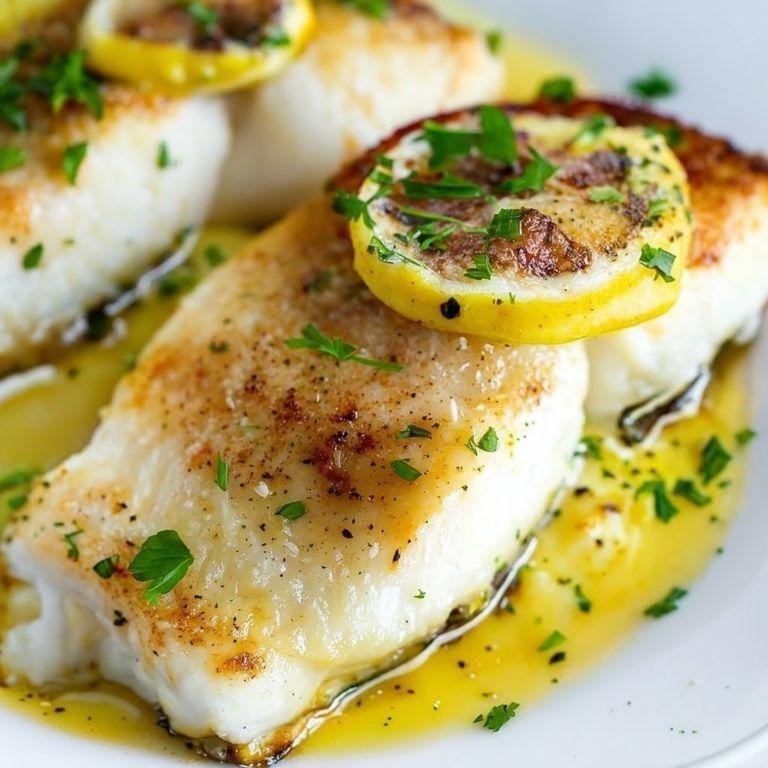
H
ave you ever wanted a restaurant-quality seafood dish that comes together with minimal effort? This lemon garlic butter baked cod delivers tender, flaky fish with bright, zesty flavors that will impress any dinner guest. Let me walk you through each simple step to ensure perfect results every time.
5
servings10
minutes15
minutesIngredients
– 4 cod fillets (about 6 oz each), patted dry with paper towels
– 3 tbsp unsalted butter, melted
– 2 tbsp fresh lemon juice
– 3 garlic cloves, minced
– 1 tsp lemon zest
– 1/4 tsp salt
– 1/8 tsp black pepper
– 1 tbsp fresh parsley, chopped
– Lemon slices for garnish (optional)
Instructions
1. Preheat your oven to 400°F and lightly grease a 9×13 inch baking dish with butter or cooking spray.
2. Pat the cod fillets completely dry with paper towels to ensure proper browning and seasoning adherence.
3. Arrange the dried cod fillets in a single layer in the prepared baking dish, ensuring they don’t touch for even cooking.
4. In a small bowl, whisk together the melted butter, lemon juice, minced garlic, and lemon zest until fully combined.
5. Brush the butter mixture evenly over all surfaces of each cod fillet, coating thoroughly.
6. Sprinkle the salt and black pepper evenly over the seasoned fillets.
7. Place the baking dish in the preheated oven and bake for 12-15 minutes, until the fish flakes easily with a fork and reaches an internal temperature of 145°F.
8. Remove the baking dish from the oven and let the cod rest for 2 minutes to allow juices to redistribute.
9. Sprinkle the chopped fresh parsley over the hot cod fillets just before serving.
10. Garnish with lemon slices if desired for extra visual appeal and citrus flavor.
Just out of the oven, this cod boasts beautifully flaky flesh that separates cleanly with a fork, infused throughout with the rich garlic butter and bright lemon notes. The buttery sauce created during baking makes a perfect drizzle over steamed rice or roasted vegetables. For a complete meal, serve alongside crusty bread to soak up every last drop of the flavorful pan juices.
Honey Mustard Baked Sea Bass

For a foolproof fish dinner that feels both elegant and approachable, this honey mustard baked sea bass delivers tender, flaky fillets with a sweet-savory glaze. Following these methodical steps will ensure perfectly cooked fish every time, even for kitchen beginners. You’ll be amazed at how simple ingredients create such impressive results.
2
servings10
minutes16
minutesIngredients
- 2 sea bass fillets (6 oz each), skin-on for crispiness
- 3 tbsp Dijon mustard (or whole grain for texture)
- 2 tbsp honey (warmed slightly if thick)
- 1 tbsp olive oil (or any neutral oil)
- 1 tsp lemon juice (freshly squeezed preferred)
- 1/2 tsp garlic powder
- 1/4 tsp smoked paprika (for depth)
- 1/4 tsp black pepper (freshly ground)
- 1/4 tsp salt (fine sea salt recommended)
Instructions
- Preheat your oven to 400°F and position the rack in the center for even heating.
- Pat the sea bass fillets completely dry with paper towels to ensure crispy skin.
- Brush a baking sheet with 1 tablespoon of olive oil to prevent sticking.
- Place the fillets skin-side down on the prepared baking sheet, spacing them 2 inches apart.
- In a small bowl, whisk together 3 tablespoons Dijon mustard, 2 tablespoons honey, 1 teaspoon lemon juice, 1/2 teaspoon garlic powder, 1/4 teaspoon smoked paprika, 1/4 teaspoon black pepper, and 1/4 teaspoon salt until smooth.
- Spread the honey mustard mixture evenly over the top and sides of each fillet using a pastry brush, coating completely.
- Bake at 400°F for 12-14 minutes until the internal temperature reaches 145°F and the flesh flakes easily with a fork.
- Switch your oven to broil on high and cook for 1-2 minutes until the glaze bubbles and caramelizes slightly.
- Remove the baking sheet from the oven using oven mitts and let the fish rest for 3 minutes before serving.
Buttery and moist with a delicate flake, the sea bass pairs beautifully with the sweet-tangy crust that forms during baking. Serve it over quinoa with roasted asparagus for a complete meal, or flake it into tacos with cabbage slaw for a creative twist. The contrast between the crisp skin and tender flesh makes each bite satisfyingly textured.
Mediterranean Baked Snapper
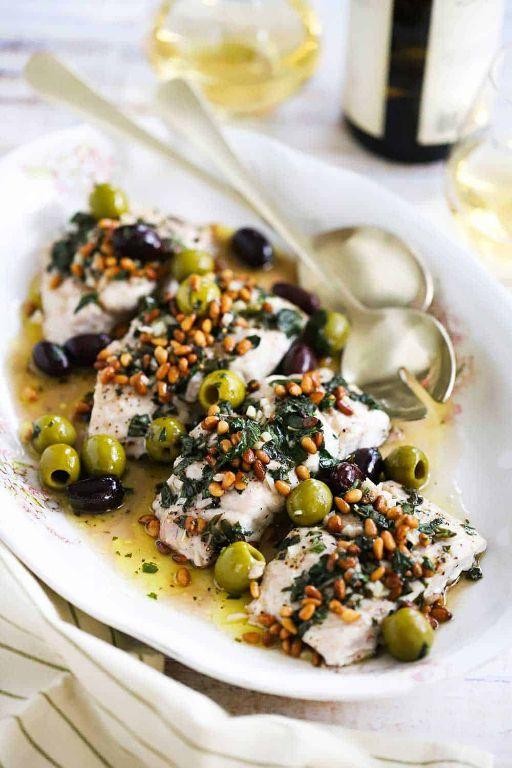
Here’s a straightforward Mediterranean baked snapper recipe that yields tender, flaky fish with vibrant flavors. Having this dish ready in under 30 minutes makes it perfect for busy weeknights when you want something healthy yet satisfying. Just follow these simple steps for restaurant-quality results at home.
2
servings10
minutes25
minutesIngredients
– 1 whole red snapper (about 2 lbs), scaled and gutted
– 2 tbsp olive oil (or any neutral oil)
– 3 garlic cloves, minced
– 1 lemon, thinly sliced
– 1 tsp dried oregano
– 1/2 tsp salt
– 1/4 tsp black pepper
– 1/4 cup kalamata olives, pitted
– 2 tbsp fresh parsley, chopped
Instructions
1. Preheat your oven to 400°F and position the rack in the center.
2. Pat the snapper completely dry inside and out with paper towels.
3. Make three diagonal slashes about 1-inch apart on each side of the fish.
4. Rub the olive oil evenly over the entire surface of the fish.
5. Combine the minced garlic, oregano, salt, and pepper in a small bowl.
6. Stuff the seasoning mixture into the fish cavity and slashes.
7. Arrange the lemon slices inside the cavity and over the top of the fish.
8. Scatter the kalamata olives around the fish in the baking dish.
9. Bake for 20-25 minutes until the flesh flakes easily with a fork.
10. Remove from oven and let rest for 3 minutes before serving.
11. Sprinkle with fresh parsley just before serving.
Juicy and aromatic, this snapper develops a beautifully crisp skin while staying remarkably moist inside. The briny olives and bright lemon create a perfect balance against the mild, sweet fish. Try serving it over couscous to soak up the delicious pan juices, or flake it into tacos with a quick cabbage slaw for a fun twist.
Spicy Cajun Baked Catfish
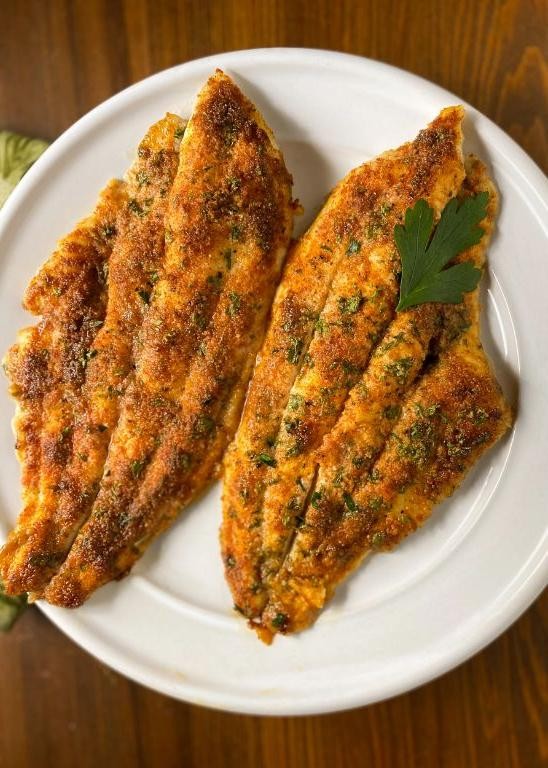
Let’s create a perfectly seasoned baked catfish that brings the bold flavors of Louisiana right to your kitchen. Learning to balance the spicy Cajun seasoning with the delicate fish will give you a restaurant-quality dish with minimal effort. This method ensures crispy edges and tender, flaky fish every time.
3
servings10
minutes15
minutesIngredients
- 4 catfish fillets (6 oz each), patted dry with paper towels
- 2 tbsp olive oil (or any neutral oil)
- 2 tbsp Cajun seasoning blend (adjust spice level if needed)
- 1 tsp garlic powder
- 1 tsp smoked paprika
- 1/2 tsp salt
- 1 lemon, cut into wedges
- Fresh parsley for garnish (optional)
Instructions
- Preheat your oven to 400°F and line a baking sheet with parchment paper.
- Pat the catfish fillets completely dry with paper towels to ensure crispy skin.
- Brush both sides of each fillet evenly with olive oil using a pastry brush.
- In a small bowl, combine Cajun seasoning, garlic powder, smoked paprika, and salt.
- Sprinkle the seasoning mixture generously over both sides of each fillet, pressing gently to adhere.
- Arrange the seasoned fillets in a single layer on the prepared baking sheet, ensuring they don’t touch.
- Bake at 400°F for 12-15 minutes until the fish flakes easily with a fork and edges are golden.
- Check for doneness by inserting a fork into the thickest part – it should separate cleanly into flakes.
- Remove from oven and let rest for 2 minutes on the baking sheet before serving.
- Squeeze fresh lemon juice over the hot fillets and garnish with chopped parsley if desired.
Perfectly baked catfish emerges with a crisp, spice-crusted exterior that gives way to moist, tender flakes inside. The smoky paprika and garlic notes complement the fish’s mild sweetness beautifully. Try serving it over creamy grits or with a crisp coleslaw to balance the heat, or flake it into tacos with avocado crema for a fun twist.
Garlic Dijon Baked Halibut

Let’s master this simple yet elegant baked halibut that transforms basic ingredients into a restaurant-quality meal right in your own kitchen. Learning this method will give you confidence with fish cookery while delivering impressive results every time.
5
servings15
minutes15
minutesIngredients
– 1.5 lbs halibut fillets (skin removed, pat dry with paper towels)
– 3 tbsp olive oil (or any neutral oil)
– 2 tbsp Dijon mustard
– 4 garlic cloves (minced, about 1 tbsp)
– 1 tbsp lemon juice (freshly squeezed)
– 1 tsp dried thyme (or 1 tbsp fresh)
– 1/2 tsp salt
– 1/4 tsp black pepper (freshly ground)
– 1 lemon (sliced into 1/4-inch rounds)
– 2 tbsp chopped fresh parsley (for garnish)
Instructions
1. Preheat your oven to 400°F and position the rack in the center.
2. Pat the halibut fillets completely dry with paper towels to ensure proper browning.
3. In a small bowl, whisk together olive oil, Dijon mustard, minced garlic, lemon juice, dried thyme, salt, and black pepper until fully combined.
4. Place the halibut fillets in a baking dish just large enough to hold them without crowding.
5. Spread the garlic-Dijon mixture evenly over the top and sides of each fillet using a pastry brush or spoon.
6. Arrange lemon slices in a single layer beneath and around the fish to create a citrus-infused cooking bed.
7. Bake at 400°F for 12-15 minutes until the internal temperature reaches 145°F and the fish flakes easily with a fork.
8. Check for doneness by inserting a fork at the thickest part – the flesh should appear opaque and separate cleanly.
9. Remove from oven and let rest for 3 minutes to allow juices to redistribute throughout the fish.
10. Garnish with chopped fresh parsley just before serving.
Outstandingly flaky and moist, this halibut boasts a savory garlic crust with the subtle tang of Dijon that permeates every tender bite. The lemon-infused cooking method keeps the fish remarkably juicy while creating a light pan sauce perfect for drizzling over accompanying roasted vegetables or fluffy rice.
Italian Herb Baked Sole
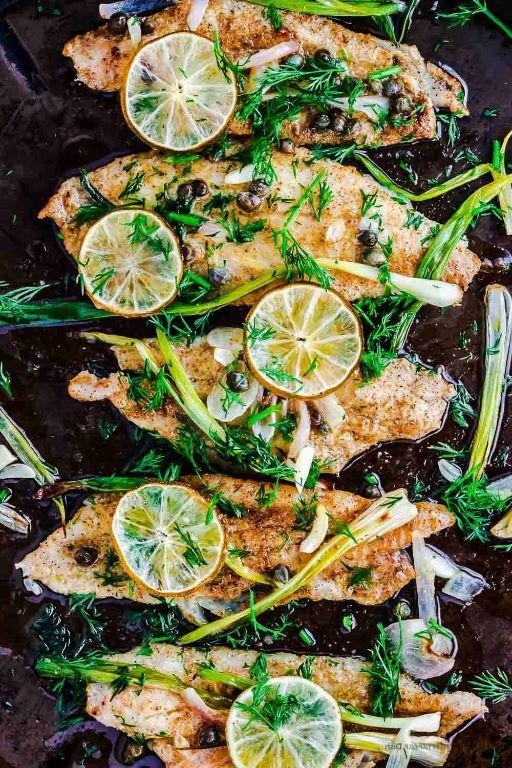
Even the most novice cooks can master this elegant Italian Herb Baked Sole with my methodical guidance. This recipe transforms simple white fish into a flavorful, restaurant-quality dish using fresh herbs and pantry staples. Follow each step precisely for perfectly flaky results every time.
3
servings10
minutes15
minutesIngredients
– 4 sole fillets (6 oz each), patted dry with paper towels
– 3 tbsp olive oil (or any neutral oil)
– 2 tbsp fresh lemon juice
– 2 tsp dried Italian seasoning
– 1 tsp garlic powder
– 1/2 tsp salt
– 1/4 tsp black pepper
– 2 tbsp chopped fresh parsley for garnish
Instructions
1. Preheat your oven to 400°F and lightly grease a 9×13-inch baking dish with 1 tablespoon of olive oil.
2. Pat the sole fillets completely dry with paper towels to ensure proper browning and seasoning adherence.
3. Arrange the dried fillets in a single layer in the prepared baking dish without overlapping.
4. Drizzle the remaining 2 tablespoons of olive oil evenly over all fillets using a spoon or pastry brush.
5. Squeeze 2 tablespoons of fresh lemon juice directly over each fillet, distributing it evenly.
6. In a small bowl, combine 2 teaspoons dried Italian seasoning, 1 teaspoon garlic powder, 1/2 teaspoon salt, and 1/4 teaspoon black pepper.
7. Sprinkle the seasoning mixture evenly over all fillets, coating the entire surface of each piece.
8. Bake at 400°F for 12-15 minutes until the fish flakes easily with a fork and reaches an internal temperature of 145°F.
9. Remove from oven and let rest for 2 minutes to allow juices to redistribute throughout the fish.
10. Garnish with 2 tablespoons of chopped fresh parsley just before serving.
Versatile enough for weeknights yet elegant for company, this baked sole emerges with a delicate, flaky texture that melts in your mouth. The Italian herb crust creates a fragrant aroma while the lemon brightens each buttery bite. Try serving over lemon herb quinoa or alongside roasted asparagus for a complete Mediterranean-inspired meal.
Pesto Crusted Baked Rainbow Trout

Envision a simple yet elegant dinner that comes together with minimal effort but delivers maximum flavor. This pesto-crusted rainbow trout bakes to perfection in under 30 minutes, making it ideal for busy weeknights when you want something healthy and impressive. The vibrant green crust locks in moisture while infusing the delicate fish with herbaceous notes.
2
servings10
minutes22
minutesIngredients
– 2 whole rainbow trout (about 1 lb each), cleaned and scaled
– 1/2 cup prepared basil pesto
– 1 lemon, thinly sliced
– 2 tbsp olive oil (or any neutral oil)
– 1/2 tsp kosher salt
– 1/4 tsp black pepper (freshly ground preferred)
– Fresh parsley for garnish (optional)
Instructions
1. Preheat your oven to 400°F and line a baking sheet with parchment paper for easy cleanup.
2. Pat the rainbow trout completely dry inside and out with paper towels to ensure crisp skin.
3. Brush both sides of each trout evenly with olive oil using a pastry brush.
4. Season the cavity and exterior of each trout with kosher salt and black pepper.
5. Stuff 3-4 lemon slices inside each trout cavity to infuse flavor during baking.
6. Spread 1/4 cup of prepared basil pesto evenly over the top surface of each trout, covering it completely.
7. Arrange the trout in a single layer on the prepared baking sheet, ensuring they don’t touch.
8. Bake at 400°F for 18-22 minutes until the flesh flakes easily with a fork and reaches 145°F internally.
9. Remove from oven and let rest for 3 minutes before serving to allow juices to redistribute.
10. Garnish with fresh parsley and remaining lemon slices if desired.
Knowing the pesto forms a flavorful crust that seals in the trout’s natural moisture creates exceptionally tender, flaky flesh. The bright herbal notes complement the mild fish beautifully, while the lemon slices baked inside provide subtle citrus undertones. For a complete meal, serve alongside roasted potatoes or over a bed of quinoa to soak up the delicious pan juices.
Soy Ginger Baked Mackerel
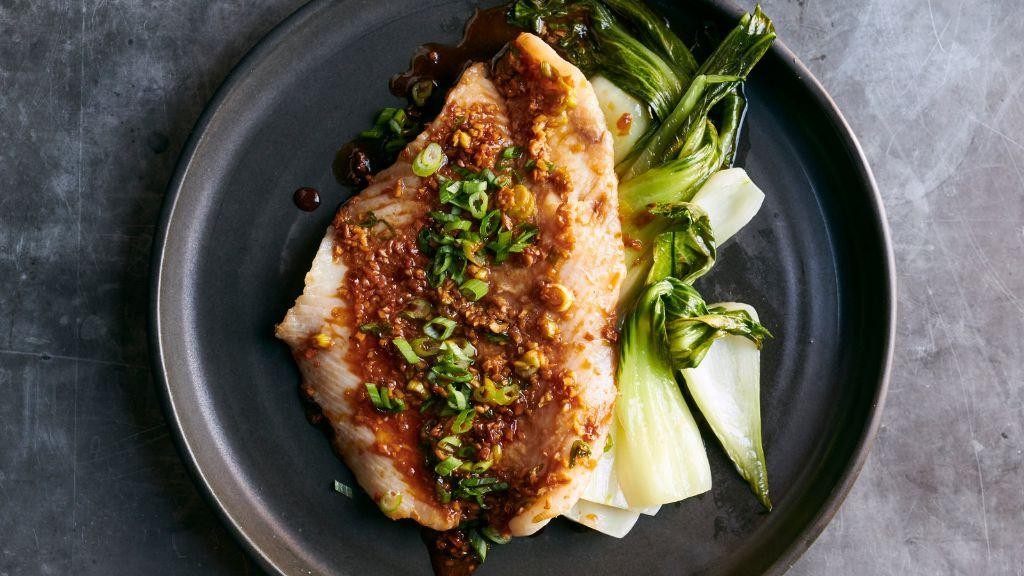
Mackerel deserves more attention in American kitchens, especially when prepared with this simple soy-ginger marinade that transforms the fish into a tender, flavorful main course. This baked version requires minimal effort but delivers maximum flavor, making it perfect for busy weeknights when you want something healthy and satisfying without spending hours in the kitchen. The combination of savory soy sauce and zesty ginger creates a beautiful glaze that caramelizes slightly during baking.
2
servings20
minutes20
minutesIngredients
– 2 whole mackerel (about 1.5 lbs total), cleaned and scaled
– ¼ cup soy sauce (or tamari for gluten-free)
– 2 tbsp grated fresh ginger (use a microplane for finest texture)
– 3 cloves garlic, minced
– 1 tbsp honey (or maple syrup for vegan option)
– 1 tbsp rice vinegar
– 1 tsp sesame oil (toasted variety for deeper flavor)
– 2 tbsp vegetable oil (or any neutral high-heat oil)
– ½ tsp black pepper
– 2 scallions, thinly sliced (both white and green parts)
– 1 lemon, cut into wedges
Instructions
1. Preheat your oven to 400°F and line a baking sheet with parchment paper.
2. Pat the mackerel completely dry with paper towels, including inside the cavity.
3. Make three diagonal slashes about ½-inch deep on each side of both fish to help the marinade penetrate.
4. In a small bowl, whisk together soy sauce, grated ginger, minced garlic, honey, rice vinegar, sesame oil, vegetable oil, and black pepper until fully combined.
5. Place the mackerel on the prepared baking sheet and brush the marinade generously over both sides and inside the cavities.
6. Let the fish marinate at room temperature for 15 minutes while the oven finishes heating.
7. Transfer the baking sheet to the middle rack of the preheated oven.
8. Bake for 18-20 minutes, or until the fish flakes easily with a fork and the skin appears slightly crispy.
9. Remove from oven and immediately sprinkle with sliced scallions.
10. Serve the baked mackerel directly from the baking sheet with lemon wedges on the side.
Crispy-skinned and flaky, this soy-ginger mackerel develops a beautiful caramelized crust while remaining incredibly moist inside. The ginger provides a warm, aromatic quality that balances the salty-sweet marinade perfectly. For a complete meal, serve it over steamed jasmine rice to soak up the delicious pan juices, or flake the fish into grain bowls with quick-pickled vegetables.
Tomato Basil Baked Haddock
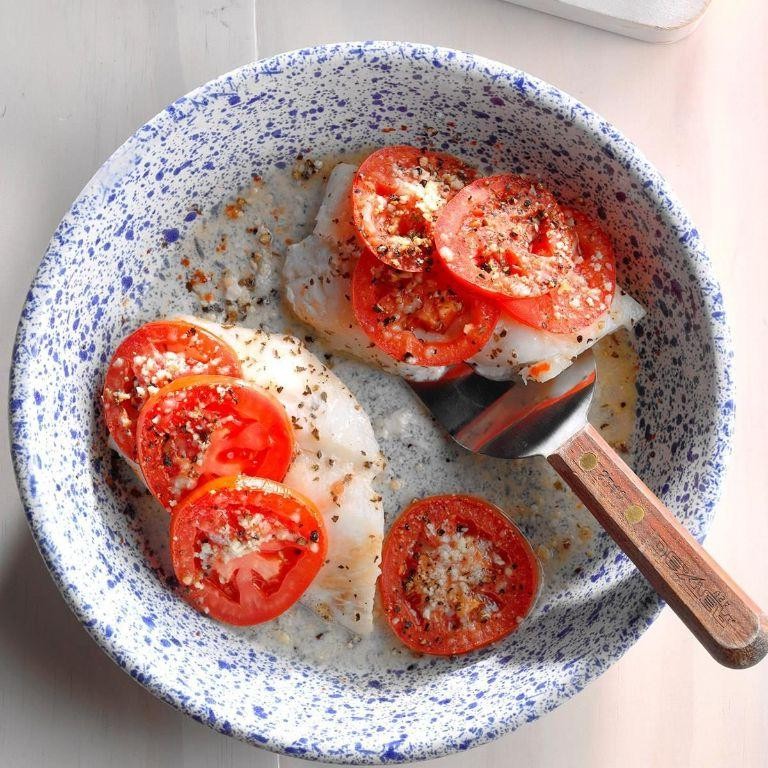
Baking fish can feel intimidating, but this tomato basil haddock recipe breaks it down into simple, foolproof steps that yield restaurant-quality results right from your home oven. By layering fresh ingredients and following precise timing, you’ll create a moist, flavorful dish that’s perfect for weeknight dinners yet impressive enough for company. Let’s walk through each step together to ensure your success in the kitchen.
2
servings15
minutes22
minutesIngredients
– 1.5 lbs haddock fillets (thaw if frozen, pat dry thoroughly)
– 2 cups cherry tomatoes, halved (or substitute Roma tomatoes)
– 1/4 cup fresh basil leaves, chopped (packed for maximum flavor)
– 3 tbsp olive oil (or any neutral oil)
– 2 tbsp lemon juice (freshly squeezed for brightness)
– 2 cloves garlic, minced (adjust to taste)
– 1/2 tsp salt (fine sea salt preferred)
– 1/4 tsp black pepper (freshly ground if possible)
– 1/4 tsp red pepper flakes (optional, for subtle heat)
Instructions
1. Preheat your oven to 400°F and lightly grease a 9×13-inch baking dish with 1 tablespoon of olive oil.
2. Pat the haddock fillets completely dry with paper towels to ensure a crispier finish.
3. Arrange the fillets in a single layer in the prepared baking dish, leaving space between them for even cooking.
4. In a medium bowl, combine the halved cherry tomatoes, chopped basil, minced garlic, remaining 2 tablespoons olive oil, lemon juice, salt, black pepper, and red pepper flakes if using.
5. Spoon the tomato-basil mixture evenly over the haddock fillets, covering them completely.
6. Bake uncovered for 18-22 minutes, until the fish flakes easily with a fork and reaches an internal temperature of 145°F.
7. Remove from the oven and let rest for 3 minutes before serving to allow juices to redistribute.
Carefully flaking apart the tender haddock reveals how the tomatoes break down into a light sauce that soaks into every bite. The basil infuses the dish with a fresh, aromatic quality that balances the mild sweetness of the fish. For a complete meal, serve it over creamy polenta or alongside crusty bread to soak up the flavorful juices.
Dijon Dill Baked Grouper

Frequently, home cooks hesitate when it comes to fish, but this Dijon Dill Baked Grouper is designed to build confidence with its straightforward, foolproof method. Follow these steps precisely, and you’ll achieve a moist, flavorful result every single time, turning a simple fillet into a restaurant-worthy meal right in your own kitchen.
2
servings10
minutes15
minutesIngredients
- 1 lb grouper fillets, about 1-inch thick (or other firm white fish like cod)
- 2 tbsp Dijon mustard
- 1 tbsp fresh lemon juice
- 1 tbsp olive oil (or any neutral oil)
- 1 tbsp fresh dill, chopped (or 1 tsp dried dill)
- 1/4 tsp garlic powder
- 1/4 tsp kosher salt
- 1/8 tsp black pepper
- Lemon wedges for serving
Instructions
- Preheat your oven to 400°F (200°C) and line a baking sheet with parchment paper to prevent sticking.
- Pat the grouper fillets completely dry with paper towels, which helps the coating adhere and promotes even browning.
- In a small bowl, whisk together the Dijon mustard, lemon juice, olive oil, fresh dill, garlic powder, kosher salt, and black pepper until smooth.
- Brush the mustard-dill mixture evenly over the top and sides of each grouper fillet, covering all surfaces for maximum flavor.
- Place the coated fillets on the prepared baking sheet, ensuring they are not touching to allow hot air to circulate.
- Bake the grouper in the preheated oven for 12-15 minutes, or until the internal temperature reaches 145°F and the flesh flakes easily with a fork.
- Remove the baking sheet from the oven and let the fish rest for 2 minutes on the sheet before serving to allow the juices to redistribute.
- Serve the baked grouper immediately with fresh lemon wedges on the side for squeezing over the top.
Just out of the oven, the grouper boasts a firm yet tender flake that holds together beautifully, while the Dijon crust provides a subtle tang that complements the fresh dill’s herbal notes. For a complete meal, serve it over a bed of quinoa with roasted asparagus, or flake the leftovers into a salad for lunch the next day—the flavors meld even better after a night in the refrigerator.
Chili Lime Baked Black Cod
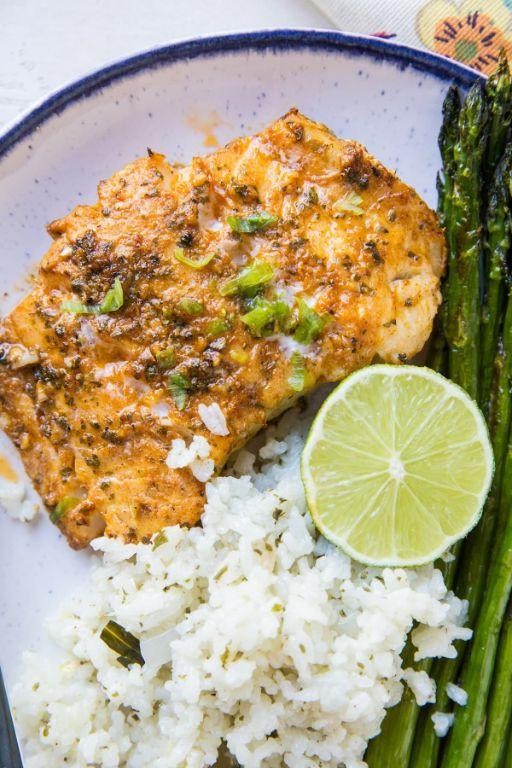
A perfectly balanced seafood dinner doesn’t have to be complicated, and this chili lime baked black cod proves just that. An approachable recipe that delivers restaurant-quality flavor with minimal effort, it’s ideal for busy weeknights when you want something special without the fuss. Let’s walk through each step together to ensure your fish turns out flaky, moist, and bursting with zesty flavor.
5
servings10
minutes15
minutesIngredients
– 1.5 lbs black cod fillets (skin-on or skinless, patted dry)
– 2 tbsp olive oil (or any neutral oil)
– 2 tbsp fresh lime juice (about 1 lime)
– 1 tsp chili powder (mild or spicy, adjust to preference)
– 1/2 tsp garlic powder
– 1/2 tsp smoked paprika
– 1/4 tsp salt (fine sea salt works best)
– 1/4 tsp black pepper (freshly ground for more flavor)
– Fresh cilantro leaves (for garnish, optional)
– Lime wedges (for serving)
Instructions
1. Preheat your oven to 400°F and line a baking sheet with parchment paper to prevent sticking.
2. Pat the black cod fillets completely dry with paper towels—this helps the seasoning adhere and promotes browning.
3. In a small bowl, whisk together the olive oil, lime juice, chili powder, garlic powder, smoked paprika, salt, and black pepper until well combined.
4. Brush the spice mixture evenly over both sides of each cod fillet, coating all surfaces for maximum flavor.
5. Arrange the seasoned fillets in a single layer on the prepared baking sheet, leaving space between them for even air circulation.
6. Bake at 400°F for 12–15 minutes, until the fish flakes easily with a fork and reaches an internal temperature of 145°F.
7. Remove the baking sheet from the oven and let the cod rest for 2 minutes—this allows the juices to redistribute, keeping it moist.
8. Garnish with fresh cilantro leaves and serve immediately with lime wedges on the side for squeezing over the top. Out of the oven, the cod boasts a tender, buttery texture that flakes apart beautifully, with a bright, tangy lime kick and subtle smoky heat from the chili and paprika. Try serving it over cilantro-lime rice or with a crisp slaw to balance the richness, or flake it into tacos for a fun, interactive meal.
Garlic Parmesan Baked Red Snapper

Many home cooks find fish intimidating, but this garlic parmesan baked red snapper recipe breaks it down into simple, foolproof steps that guarantee restaurant-quality results right from your own kitchen. Mastering this dish will give you confidence to explore more seafood recipes while impressing family and friends with minimal effort.
2
servings10
minutes15
minutesIngredients
– 2 red snapper fillets (about 6 oz each, skin-on or skinless)
– 3 tbsp olive oil (or any neutral oil)
– 4 cloves garlic, minced (about 1 tbsp)
– 1/2 cup grated parmesan cheese (freshly grated melts better)
– 1/4 cup panko breadcrumbs (for extra crunch)
– 1 tbsp lemon juice (freshly squeezed preferred)
– 1 tsp dried parsley (or 1 tbsp fresh chopped)
– 1/2 tsp paprika (for color and mild heat)
– 1/4 tsp black pepper (freshly ground)
– 1/4 tsp salt (adjust to taste)
Instructions
1. Preheat your oven to 400°F and line a baking sheet with parchment paper.
2. Pat the red snapper fillets completely dry with paper towels to ensure crispy topping.
3. In a small bowl, combine olive oil, minced garlic, lemon juice, salt, and black pepper.
4. Brush this oil mixture evenly over both sides of each snapper fillet.
5. In a separate bowl, mix parmesan cheese, panko breadcrumbs, dried parsley, and paprika.
6. Press the parmesan mixture firmly onto the top surface of each fillet, creating an even layer.
7. Place the coated fillets on the prepared baking sheet, leaving space between them for even cooking.
8. Bake at 400°F for 12-15 minutes until the internal temperature reaches 145°F.
9. Check for doneness by ensuring the fish flakes easily with a fork and the topping is golden brown.
10. Let the fish rest for 2-3 minutes before serving to allow juices to redistribute. Every bite reveals flaky, moist fish with a satisfying crunch from the golden parmesan crust. The garlic infuses throughout the tender snapper while the lemon brightens each mouthful. Consider serving over creamy polenta or alongside roasted asparagus for a complete meal that highlights the fish’s delicate texture.
Brown Sugar Baked Trout
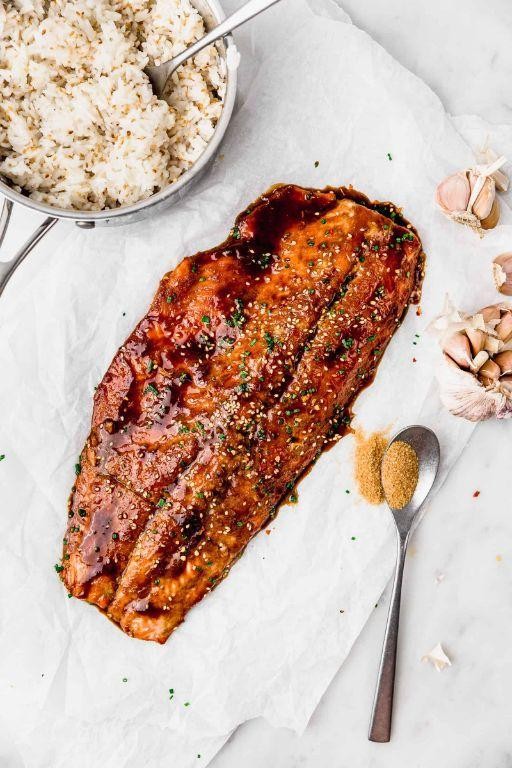
Perfectly glazed and wonderfully simple, this brown sugar baked trout transforms ordinary fish into an elegant weeknight dinner that even novice cooks can master. Preparing this dish requires just a few pantry staples and minimal hands-on time, making it ideal for busy evenings when you want something special without the fuss. Follow these clear steps to create tender, flaky trout with a caramelized sweet-savory crust that will impress your family.
2
servings10
minutes18
minutesIngredients
- 2 whole trout (about 1 lb each), cleaned and scaled – ask your fishmonger to do this for you
- 3 tbsp brown sugar – packed firmly for accurate measurement
- 2 tbsp olive oil – or any neutral oil like avocado oil
- 1 tbsp soy sauce – use reduced-sodium if preferred
- 2 cloves garlic, minced – about 1 tsp
- 1 tsp smoked paprika – adds depth to the sweetness
- ½ tsp black pepper – freshly ground works best
- ¼ tsp salt – adjust based on your soy sauce’s saltiness
- 1 lemon, sliced into thin rounds – for both cooking and garnish
Instructions
- Preheat your oven to 400°F and line a baking sheet with parchment paper to prevent sticking.
- Pat the trout completely dry inside and out with paper towels – this ensures crispy skin.
- In a small bowl, whisk together brown sugar, olive oil, soy sauce, minced garlic, smoked paprika, black pepper, and salt until a thick paste forms.
- Rub the brown sugar mixture evenly over both the outside and inside cavities of both trout.
- Place 3-4 lemon slices inside each trout cavity for aromatic steam during baking.
- Arrange the trout on the prepared baking sheet, spacing them at least 2 inches apart for even cooking.
- Bake at 400°F for 15-18 minutes until the flesh flakes easily with a fork and the sugar glaze is bubbly.
- Check for doneness by inserting a fork into the thickest part – the flesh should be opaque and separate cleanly.
- Remove from oven and let rest for 3 minutes before serving to allow juices to redistribute.
Succulent and flaky, the trout develops a beautiful caramelized crust that contrasts wonderfully with the moist, tender flesh beneath. The brown sugar creates a subtle sweetness that balances perfectly with the savory soy and smoky paprika notes. Serve this elegant fish over a bed of quinoa with roasted asparagus, or flake it into tacos with fresh slaw for a creative twist on taco night.
Sicilian Style Baked Barramundi

Unlock the vibrant flavors of Sicily with this simple yet impressive baked barramundi recipe. Using readily available ingredients, we’ll create a Mediterranean masterpiece that’s perfect for weeknight dinners yet elegant enough for company. You’ll be amazed how these simple steps transform humble ingredients into restaurant-quality seafood.
2
servings10
minutes14
minutesIngredients
- 2 barramundi fillets (6 oz each), skin-on for crispy texture
- 3 tablespoons extra virgin olive oil, divided (or avocado oil)
- 1 lemon, thinly sliced into 8 rounds
- 2 cloves garlic, minced (about 2 teaspoons)
- 1 teaspoon dried oregano
- ½ teaspoon red pepper flakes (reduce to ¼ tsp for mild heat)
- ¼ cup panko breadcrumbs
- 2 tablespoons chopped fresh parsley
- ½ teaspoon kosher salt
- ¼ teaspoon black pepper
Instructions
- Preheat your oven to 400°F and position the rack in the center.
- Pat barramundi fillets completely dry with paper towels to ensure crispy skin.
- Brush a baking sheet with 1 tablespoon olive oil to prevent sticking.
- Place fillets skin-side down on the prepared baking sheet, spacing them 2 inches apart.
- Rub remaining 2 tablespoons olive oil evenly over the top of each fillet.
- Sprinkle minced garlic evenly across both fillets, pressing gently to adhere.
- Season fillets with kosher salt and black pepper, distributing evenly.
- Combine panko breadcrumbs, dried oregano, and red pepper flakes in a small bowl.
- Press the breadcrumb mixture firmly onto the top surface of each fillet to create a crust.
- Arrange 4 lemon slices overlapping on top of each breadcrumb-coated fillet.
- Bake at 400°F for 12-14 minutes until the internal temperature reaches 145°F.
- Check for doneness by inserting a fork – the flesh should flake easily and appear opaque.
- Remove from oven and let rest for 3 minutes to allow juices to redistribute.
- Sprinkle chopped fresh parsley over the baked fillets just before serving.
Velvety flakes of barramundi contrast beautifully with the crispy panko crust, while the lemon slices infuse bright acidity throughout. The garlic and oregano create an aromatic Mediterranean profile that pairs wonderfully with roasted vegetables or a simple arugula salad. For an elegant presentation, serve the fillets over creamy polenta to soak up the flavorful juices.
Coconut Curry Baked Monkfish
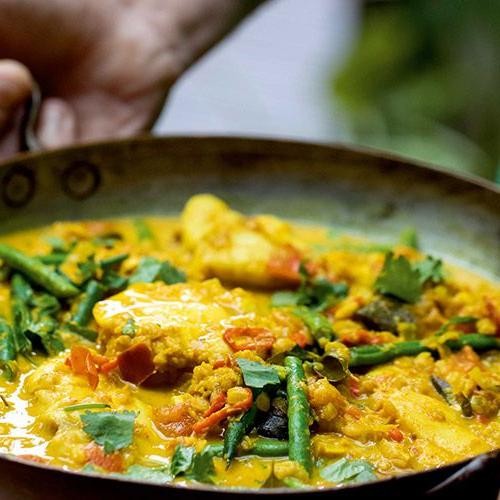
Preparing this coconut curry baked monkfish is simpler than you might think, even if you’re new to working with this elegant fish. Let’s walk through each step together to create a restaurant-quality dish in your own kitchen. You’ll be amazed at how the flavors develop through the baking process.
2
servings15
minutes25
minutesIngredients
- 1.5 lbs monkfish fillets, cut into 2-inch chunks (look for firm, pearly-white flesh)
- 1 cup full-fat coconut milk (shake the can well before opening)
- 2 tbsp red curry paste (or yellow curry paste for milder flavor)
- 1 tbsp fish sauce (provides essential umami depth)
- 1 tbsp lime juice (freshly squeezed for brightest flavor)
- 1 tsp brown sugar (helps balance the curry’s heat)
- 1 tbsp vegetable oil (or any neutral high-heat oil)
- 1/2 tsp salt (use fine sea salt for even distribution)
- 1/4 tsp black pepper (freshly ground preferred)
- 2 tbsp chopped fresh cilantro (for garnish, adds fresh herbal note)
Instructions
- Preheat your oven to 375°F and position the rack in the center of the oven.
- Pat the monkfish chunks completely dry with paper towels to ensure proper searing.
- Season all sides of the monkfish evenly with salt and black pepper.
- Heat vegetable oil in a large oven-safe skillet over medium-high heat until it shimmers, about 2 minutes.
- Place monkfish chunks in the hot skillet, leaving space between each piece to allow for proper browning.
- Sear the monkfish for 2 minutes per side until golden brown crust forms on all surfaces.
- Remove the skillet from heat and transfer the seared monkfish to a clean plate temporarily.
- Tip: Deglaze the hot skillet with 2 tablespoons of the coconut milk, scraping up all the browned bits from the bottom.
- Whisk the remaining coconut milk, red curry paste, fish sauce, lime juice, and brown sugar in the skillet until fully combined.
- Return the seared monkfish to the skillet, nestling the pieces into the curry sauce.
- Tip: Spoon some sauce over the top of each monkfish piece to keep them moist during baking.
- Place the uncovered skillet in the preheated oven and bake for 12-15 minutes until the monkfish reaches 145°F internal temperature.
- Tip: Use an instant-read thermometer inserted into the thickest part of a monkfish chunk to check for doneness.
- Remove the skillet from the oven and let it rest for 3 minutes to allow the fish to finish cooking gently.
- Sprinkle the chopped cilantro over the baked monkfish just before serving.
The finished monkfish will be firm yet tender with a delicate flake, while the curry sauce becomes rich and slightly thickened from the baking process. This dish pairs beautifully with jasmine rice to soak up the aromatic coconut curry sauce, or try serving it over zucchini noodles for a lighter option that still captures all the vibrant flavors.
Rosemary Lemon Baked Pollock
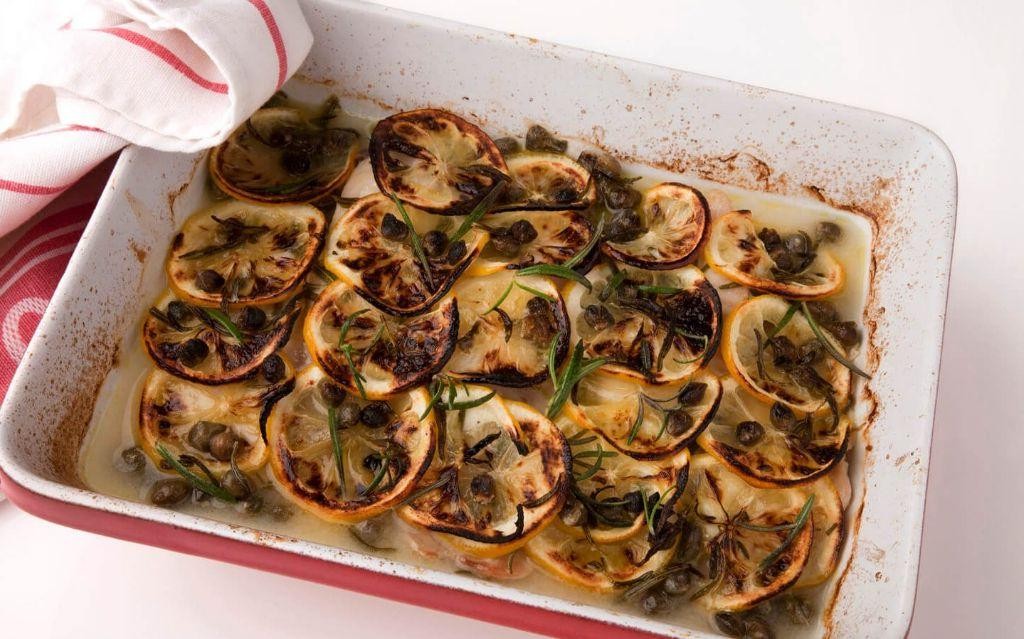
Baking fish doesn’t have to be intimidating, especially when you start with this straightforward rosemary lemon baked pollock recipe. By following these clear steps, you’ll create a flavorful, flaky fish that’s perfect for weeknight dinners yet impressive enough for guests. Let’s walk through each stage together to ensure your success in the kitchen.
3
servings10
minutes15
minutesIngredients
– 1.5 lbs pollock fillets (thaw if frozen)
– 3 tbsp olive oil (or any neutral oil)
– 2 tbsp fresh lemon juice (about 1 medium lemon)
– 2 tsp fresh rosemary, finely chopped (dried works in a pinch)
– 3 garlic cloves, minced (about 1 tbsp)
– 1/2 tsp salt (adjust to preference)
– 1/4 tsp black pepper (freshly ground preferred)
– Lemon slices for garnish (optional)
Instructions
1. Preheat your oven to 400°F and position the rack in the center.
2. Pat the pollock fillets completely dry with paper towels to ensure proper browning.
3. Whisk together olive oil, lemon juice, rosemary, garlic, salt, and pepper in a small bowl until fully combined.
4. Brush the seasoning mixture evenly over both sides of each pollock fillet using a pastry brush.
5. Arrange the coated fillets in a single layer on a parchment-lined baking sheet, ensuring they don’t touch.
6. Place lemon slices on top of the fillets for extra flavor infusion during baking.
7. Bake at 400°F for 12-15 minutes until the fish flakes easily with a fork and reaches 145°F internally.
8. Remove from oven and let rest for 2 minutes before serving to allow juices to redistribute.
Always check for doneness by inserting a fork at the thickest part—the fish should separate into clean flakes. A perfectly baked pollock will be moist and tender with bright citrus notes balanced by earthy rosemary. Consider serving it over quinoa with roasted asparagus for a complete meal that highlights the delicate texture.
Conclusion
Embark on a culinary adventure with these 30 baked fish recipes that promise delicious, healthy meals with minimal effort. We hope you find new favorites to add to your weekly rotation! Share which recipe you loved most in the comments below, and don’t forget to pin this collection on Pinterest to inspire fellow home cooks.



